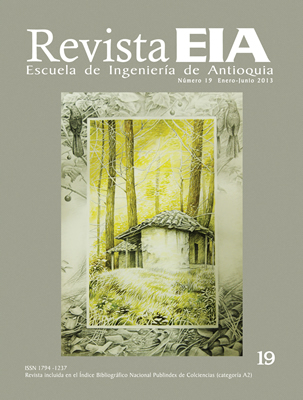REMOCIÓN DE NÍQUEL Y DQO PRESENTES EN LAS AGUAS RESIDUALES DE LA INDUSTRIA AUTOMOTRIZ MEDIANTE ELECTROCOAGULACIÓN (REMOVAL OF NICKEL AND COD PRESENT IN WASTEWATERS FROM AUTOMOTIVE INDUSTRY BY ELECTROCOAGULATION)
REMOCIÓN DE NÍQUEL Y DQO PRESENTES EN LAS AGUAS RESIDUALES DE LA INDUSTRIA AUTOMOTRIZ MEDIANTE ELECTROCOAGULACIÓN (REMOVAL OF NICKEL AND COD PRESENT IN WASTEWATERS FROM AUTOMOTIVE INDUSTRY BY ELECTROCOAGULATION)


This work is licensed under a Creative Commons Attribution-NonCommercial-NoDerivatives 4.0 International License.
Copyright statement
The authors exclusively assign to the Universidad EIA, with the power to assign to third parties, all the exploitation rights that derive from the works that are accepted for publication in the Revista EIA, as well as in any product derived from it and, in in particular, those of reproduction, distribution, public communication (including interactive making available) and transformation (including adaptation, modification and, where appropriate, translation), for all types of exploitation (by way of example and not limitation : in paper, electronic, online, computer or audiovisual format, as well as in any other format, even for promotional or advertising purposes and / or for the production of derivative products), for a worldwide territorial scope and for the entire duration of the rights provided for in the current published text of the Intellectual Property Law. This assignment will be made by the authors without the right to any type of remuneration or compensation.
Consequently, the author may not publish or disseminate the works that are selected for publication in the Revista EIA, neither totally nor partially, nor authorize their publication to third parties, without the prior express authorization, requested and granted in writing, from the Univeridad EIA.
Show authors biography
Mediante este estudio se determinó si la técnica de electrocoagulación contribuye a minimizar la concentración de níquel y materia orgánica y la demanda química de oxígeno (DQO) en las aguas residuales de la industria automotriz. Se empleó un diseño experimental factorial multinivel aleatorio en el que la densidad de la corriente y el tiempo de reacción fueron evaluados en tres niveles, mientras que la separación entre electrodos fue analizada en dos niveles. La electrocoagulación se llevó a cabo en un reactor batch usando electrodos de hierro con arreglo monopolar. Fueron utilizadas las técnicas analíticas de digestión ácida, absorción atómica de llama de aire-acetileno y reflujo cerrado-colorimétrico (micro DQO) para determinar el contenido de los contaminantes. Las condiciones con que se obtuvo la mayor descontaminación del agua analizada fue con la densidad de corriente aplicada: 1,04 A/dm2 y tiempo de operación: 17 minutos; con estas variables se observó que la separación electródica no influyó. Los resultados indican que la electrocoagulación podría ser usada para disminuir el níquel y la materia orgánica (DQO) presentes en las aguas residuales de la industria automotriz.
Abstract: By means of this study was determined if the electrocoagulation technique helps to minimize the nickel andorganic matter, chemical oxygen demand (COD) concentration, present in wastewaters from automotive industry. Arandomized multilevel factorial experimental design was used; being the current density and reaction time evaluated inthree levels, while the separation between electrodes was analyzed at two levels. Electrocoagulation was carried out ina batch reactor using iron electrodes with monopolar arrangement. The acid digestion, atomic absorption air-acetyleneflame and the closed reflux-colorimetric (micro COD) analytical techniques were used to determine the content ofthe contaminants. The conditions where it got the most decontamination of the water analyzed were found; being theApplied current density: 1,04 A/dm2, operative time: 17 minutes y; did not the electrode separation influence. The resultsshow that electrocoagulation could be effective to reduce nickel and organic matter (COD) present in wastewaters fromautomotive industry.
Article visits 335 | PDF visits 171
